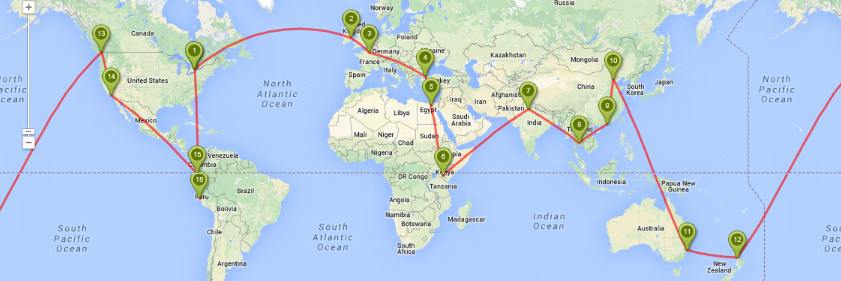After visiting places of worship of the ancient Egyptians at their temples, we decided to visit more “modern” places of worship. To do this we took a trip to Coptic Cairo.
Coptic Cairo is the oldest part of the city of Cairo. Although in most cities the oldest part is called Old (insert city name), it is called Coptic Cairo because that is the name tourists recognize.
Coptic Christians
In Egypt, 90% of the population is Muslim, while the other 10% are Coptic Christians. Throughout our travels, we have learned a lot about the Islamic faith, especially while in Israel, Turkey, and more….what was new to us, was the Coptic faith. What we learned is that the word “Coptic” is used to describe Egyptian Christians. During the reign of Roman emperor Nero, St. Mark brought Christianity to Egypt and they used the Coptic language (combination of Egyptian hieroglyphics and Greek letters) before Arabic became the official language. The Clergy is headed by the Pope of Alexandria and the current pope is Tawadros II, who took on the role November, 2012. Today, there are over 60 Coptic Bishops governing dioceses inside Egypt as well as dioceses in Jerusalem, Sudan, Western Africa, France, England, and the United States.
The Copts have a very strict fasting regime. Out of the 365 days of the year, Copts fast for over 210 days. During fasting, no animal products (meat, poultry, fish, milk, eggs, butter, etc.) are allowed. Moreover, Copts are encouraged to not have any food or drink whatsoever between sunrise and sunset. These strict fasting rules — which have resulted in a very interesting Coptic cuisine over the centuries — are usually relaxed by priests on an individual basis to accommodate for illness or weakness.
Now onto Coptic Cairo!
Babylon Fortress
In Coptic Cairo, there is a Roman fortress called Babylon Fortress. This is not where the Hanging Gardens of Babylon were located, but was for military defence. The fortress was later taken over by the Christians, which is why there are many churches built around it. Today, parts of the old wall are still standing.


Church of St. Barbara
During the time of Roman rule, Christianity was not allowed, so Christians were often tortured and killed. One of these Christians was a young girl named Barbara, who was martyred. One of the churches that we visited was named after her. Since we were there for Christmas time, the church was beautifully decorated for the holiday season, with a Nativity, balloons, and other decorations.


St. Mary’s Church
This church is very interesting because it is built into the walls of the Roman fortress, so there is a lot of empty space between the bottom of the church and the actual ground. For this reason, it is also known as the Hanging Church. It was really neat to see how the old construction was used to support the newer construction.

Church of St. Sergius
In Arabic, this church is called Abu Serga. This is a very important church because it is apparently the place where the Holy Family (the Virgin Mary, Joseph, and Baby Jesus) stayed for 3 months when they fled Jerusalem to escape Herod. The church is built over the cave where the family lived, which has the original cave floor, the place where Baby Jesus slept, and the well that the family used for drinking water. People make pilgrimages to this site as it is very holy.



Another interesting feature of the church itself are the pillars. Since the builders of the church weren’t as educated in the art of building long-lasting pillars, they took them from nearby ancient Roman and Egyptian monuments!

St. George’s Church
This is a Greek Orthodox church, which surprised me because although I know Alexander the Great was in Egypt, I didn’t expect any modern day traces of Greece. Another interesting thing that we learned was apparently the Greek “Evil Eye” is derived from the ancient Egyptian Eye of Horus. However, any Greek person would say it’s the other way around 🙂




Ben-Ezra Synagogue
This is Egypt’s oldest synagogue, however it is not frequently used. There is a very small number of Jewish people who live in Egypt (around 100-200), as most of them have left for Israel or America. As there is a small population, there is one synagogue in downtown Cairo that is mainly used. This was still a very beautiful building and I’m glad that we had the chance to visit it.
Mosque of Amr Ibn al-As
This is the oldest mosque in Egypt. It is built entirely out of alabaster, which is a beautiful white stone that allows bright light to travel through it. Outside the mosque is a big clock that was sent to Egypt from France. This “gift” was in return for the French taking one of the obelisks from Egypt and setting it up in Paris. Unfortunately, the clock stopped working a few months after it was received and it has never worked since! Meanwhile, the obelisk is still in Paris, in the Place de La Concorde.


Our time in Coptic Cairo reminded me of the time we spent in Jerusalem. There are many places of worship in one area and many people come for pilgrimages in both locations. It was really interesting to visit the different places of worship and it was a good chance to learn more about other cultures around the world.

Leave a Reply